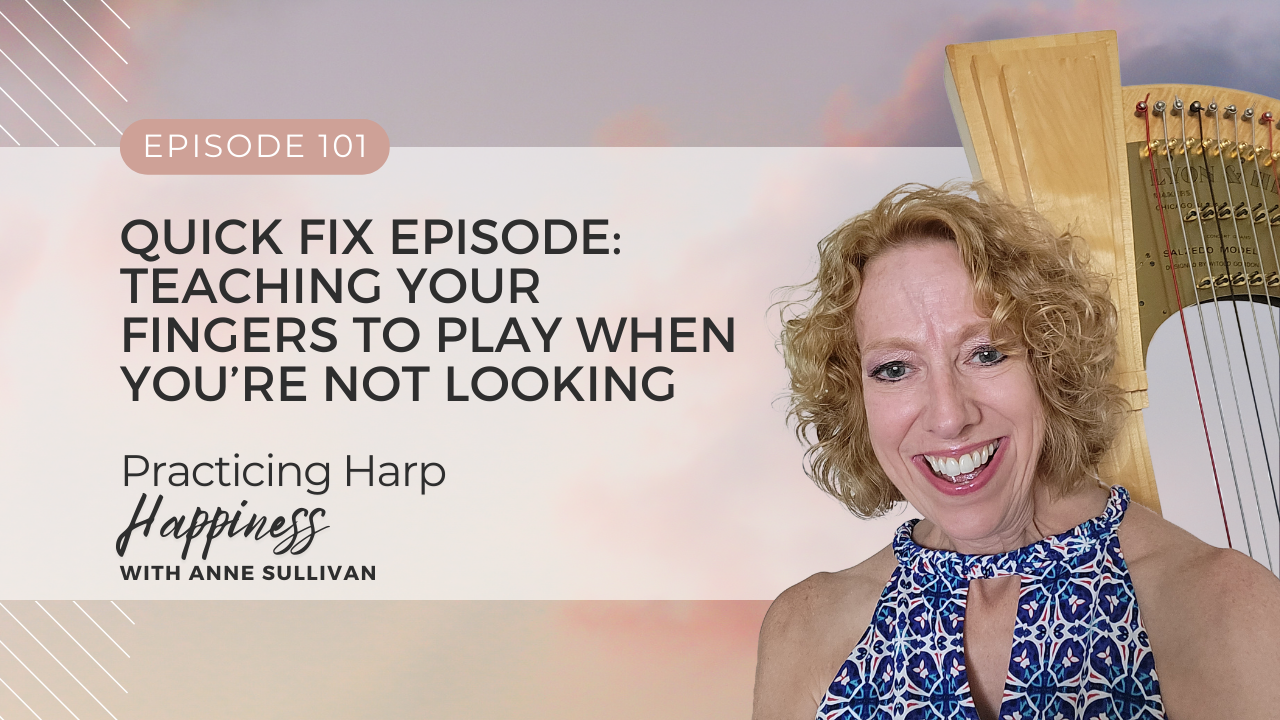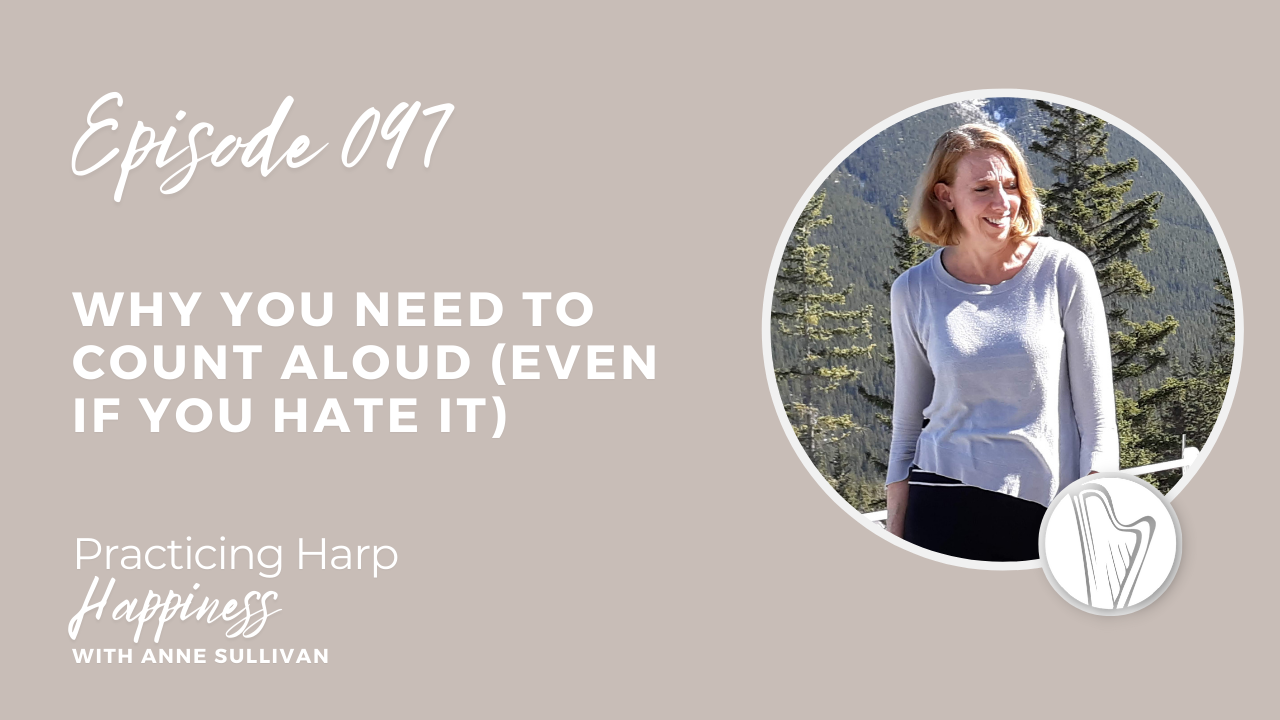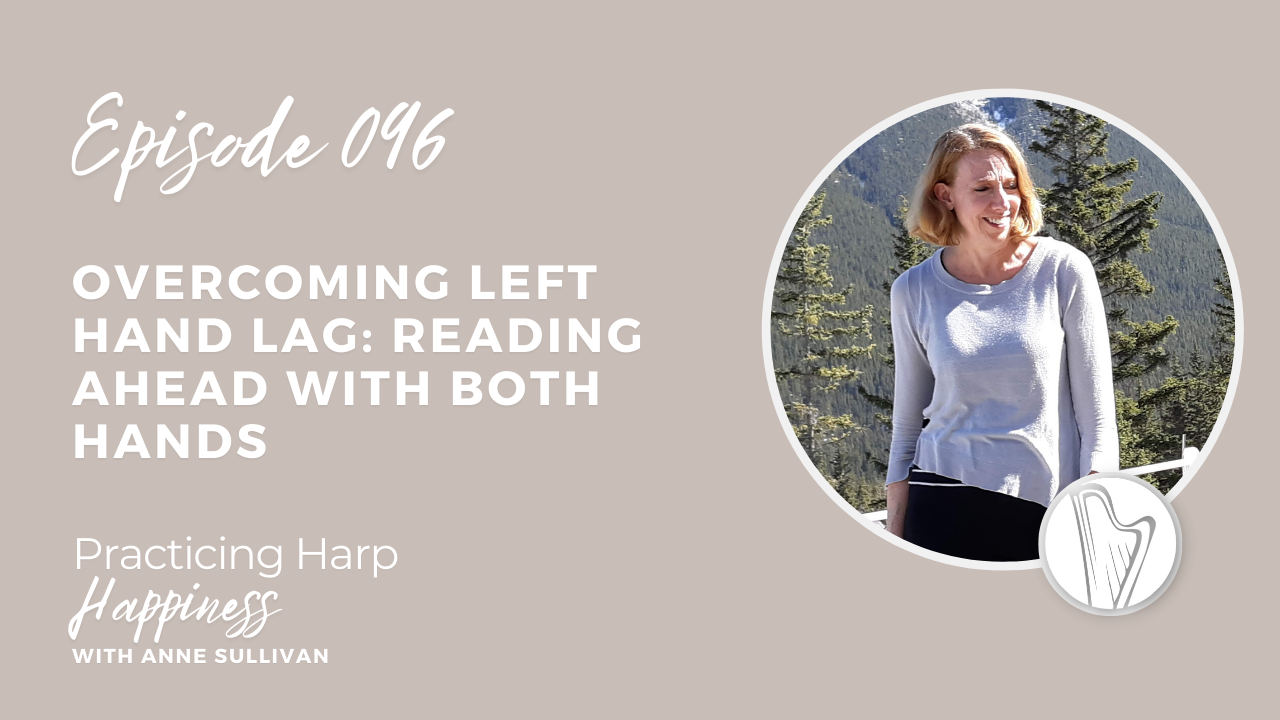Practicing Harp Happiness
#113: Three Easy Ways To Get Your Hands Playing Together

There are markers along the road in every harpist’s development, signposts that indicate you’re making progress. These are like those highway signs that tell you how many miles you are from the next town or city, like “New York City - 90 miles.” No matter how long it’s taken you to get to that point and regardless of the traffic jam ahead of you on the New Jersey Turnpike, New York City is now only 90 miles away.
Graduating from three-note chords to four-note chords is one of those markers I talk about often. Another one is fluent hands together playing.
Fluent may not be the best word to describe my meaning. It’s more a comfort level, the point at which hands together playing is not any more difficult for you than playing hands separately. Many harpists develop fluency playing hands separately and then are frustrated when that fluency doesn’t translate to their hands together playing. What they don’t realize is that the...
#111: The Ultimate Time Machine: Harness The Power Of Your Metronome

Okay, here’s my question for you today. What would be the scariest words you could hear in your lesson? I can think of lots of possibilities but I’m guessing that one of those phrases that comes to your mind might be, “I think we need to get out the metronome.”
If that’s a phrase that makes you start to squirm on your harp bench, you’re not alone. Learning to use the metronome is one of those things that we teachers often fail to teach our students. Sure, we pull out the metronome in lessons and tell our students to practice with it at home, but we don’t often really show them how to work with it or when to use it and why. We almost turn it into a punishment. I sometimes worry I sound like the Wicked Witch of the West; “Well, my pretty, you counted that badly. It’s time for the metronome for you and the little dog too!”
But the metronome is for more than just identifying and solving counting errors or uneven beats. And...
#108: Quick Fix: Buzz No More

Legendary harpist and composer Carlos Salzedo had this to say about buzzing: “It is important that there be no buzzing when replacing. Buzzing comes from lack of precision in replacing, and will be eliminated if the player replaces very accurately.”
That quote comes from the Method for the Harp book that he wrote with Lucile Lawrence, his former student and at the time that method book was written, his wife.
What is interesting about that quote is that even though Salzedo had so much to say about so many aspects of harp playing, that is all he says about buzzing, nothing more.
On the one hand, it’s enough. Every harpist should be replacing accurately in order to avoid buzzing. But we knew that much. What Salzedo leaves us wondering is exactly how we should practice accurate replacing so we don’t buzz. Unfortunately, Salzedo either thought it was too obvious to elaborate on or he wanted to keep his secrets for his students.
I imagine he thought it was...
#101: Quick Fix Episode: Teaching Your Fingers To Play When You’re Not Looking

What would you do if you were playing the harp in a concert and the lights went out?
I’m sure many of you have stories about playing the harp when there was a sudden power outage, and I have several myself. I remember one wedding when a neighborhood-wide blackout occurred just as the newly married couple kissed. The priest didn’t miss a beat, directing the acolytes to lead the bride and groom in a candlelight recessional to the back of the church. My fellow musicians and I were missing lots of beats however, as we struggled to keep playing the recessional music in the dark.
Fortunately it was a familiar tune, but even so, the other musicians finally gave up, leaving me to carry on by myself. Because I knew the piece, the notes weren’t the problem; obviously the real difficulty was not being able to see the strings.
Today’s Quick Fix podcast episode isn’t about memorizing your music or carrying a spare music stand light with you. It’s about...
#097: Why You Need To Count Aloud (Even If You Hate It)

Music is not a numbers game. You can’t quantify a moving performance or a composition with statistics like a batting average. You can’t predict how many minutes, hours, weeks or months it will take to be able to play a certain piece fluently. A player's skill isn’t solely a result of how old they are or how many years they’ve been playing. Those kinds of numbers aren’t relevant in the music world.
There are numbers that have great significance to us as musicians and harpists. Some are meaningful dates in music history, like the birth and death dates of important composers. Some numbers are important for what they represent. I’m thinking of the Roman numerals we use to describe chords and chord progressions, like a I-IV-V-I progression. Other numbers are even more practical, such as numbers for fingering. And then there are those numbers that are at the heart of our discussion today, the numbers in the time signature.
You know the numbers I mean;...
#096: Overcoming Left Hand Lag: Reading Ahead With Both Hands

Playing hands together is a topic of constant concern and endless discussion for harpists. When should you start playing hands together? Should you learn a piece hands separately first? How do you begin putting the hands together? And the most frequently asked question: why isn’t hands together working for me? As much as we debate the other questions, this last one is the hardest of all to answer.
One of the more common problems in playing hands together is one I call the “left hand lag.” The left hand lag happens when your hands are playing together sort of, but your left hand seems to be taking too much time to find the strings it needs to play. It’s not a left hand issue; your left hand plays perfectly when it plays by itself. But when you play the hands together, your left hand seems to be behind the beat. It causes hesitations that interrupt the flow of the rhythm and slow everything down.
Your teacher’s first response is likely that you...
#095: Freedom to Fly: Four Keys to Finger Facility

We all know that making music is more than playing the right notes at the right time. It’s about the heart and soul of the music, the feeling we put into it and the feeling that we communicate through it. Unfortunately, no matter how much feeling we put into the music, the actual communication of that feeling relies on our technique. It’s one of those apparent paradoxes in music study. The beauty of your music depends on the fluency of your technical performance, but a technically perfect performance may or may not be a beautiful one.
So we spend, or should be spending, a significant proportion of our practice time strengthening and securing our technical skills. We practice the notes of our pieces slowly and correctly. But often we still miss the connection between slow, technically careful playing and the facility we need to let our music flow. That connection, the missing link between slow and correct and fluid and musical, is what we will be talking about today.
...
#094: 7 Skills That Mark Your Growth

If you’re into computer games, you know it’s all about getting to the next level.
Even if you’re not into computer games, you probably know what I mean. Many computer games are built in levels and moving to the next higher level requires the player to complete certain tasks or amass a specific number of treasures or experience points. Until you can complete all the tasks, find all the treasure and do it in the time allotted without using up all your game “lives” in the process, you can’t move on. You’re stuck at that level.
Lots of gamers, I might even venture to say most gamers, get a little obsessed in the attempt to move up. They play the game over and over again, looking for the secret sequence or hidden treasure that will give them access to the next level. What I find interesting about this phenomenon is that it is so similar to getting to the next level in harp playing.
I know you didn’t think you had much in common with...
#092: Quick Fix: Roll Your Chords Right

Welcome to a “quick fix” episode of the podcast. I love these episodes because I get to teach at the harp, which is just about my favorite thing. Actually, playing music on the harp would be my favorite, but this runs a pretty close second.
Today’s quick fix is for rolled chords. Rolled chords are one of the most distinctive sounds of the harp, and they are one of our most versatile expressive tools. They can be rolled crisply with lots of energy, or they can be lush and luxurious, almost like musical dark chocolate. But they can be tricky to play well.
We’re going to cover the three most critical factors of rolling chords on this episode: the actual technique of rolling chords, how to get them to fit into your piece and not slow down the tempo, and how to practice the rolls so your fingers sound even and smooth. That’s a lot to do in one podcast show so we had better get started. If you are by your harp you might find it helpful to try these...
#089: Masterclass: The Tempo Pyramid

Today’s episode is another in our series of masterclasses, our podcast at-the-harp workshops where you can follow along with me as we do a deep dive into a vital aspect of technique or musicianship.
In this masterclass, we’ll be working on my tempo pyramid. Over the years, I have had lots of requests for reviewing my system for working a piece or a passage so that it actually gets up to tempo. This system is what I call the tempo pyramid and although the concept is fairly simple, it will definitely help you to try it out step by step with me. I won’t just walk you through the pyramid, but I’ll give you some of my bonus tips that will make it even simpler and faster. And faster is our whole focus today: getting the whole piece faster and closer to tempo, making that one difficult passage as fast as the rest of the piece, letting your fingers move faster and with more agility and security.
It’s a lot to do in one podcast episode so we need to get...

